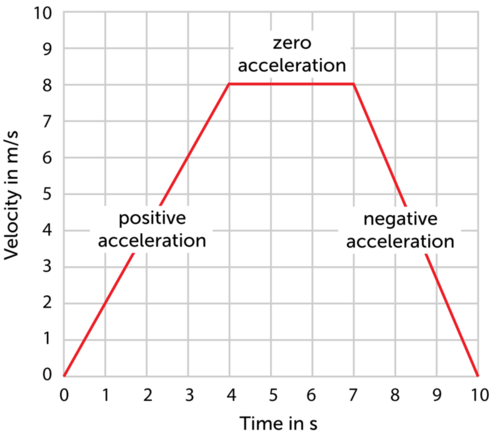2.9: Velocity vs. Time Graphs
- Page ID
- 4840

The sprinter in this image is just taking off from the starting blocks to run a short race down a straight track. She starts in a burst of speed and will pick up even more speed during the first few seconds of the race. She’ll keep running at top speed until she crosses the finish line. Only then will she slow down. Velocity is a measure of both speed and direction of motion. A change in velocity is called acceleration. In the case of the sprinter, she accelerates as she runs down the track because her speed is changing even though her direction stays the same.
Plotting Velocity Against Time
The changing velocity of the sprinter—or of any other moving person or object—can be represented by a velocity-time graph like the one in the Figure below for the sprinter. A velocity-time graph shows how velocity changes over time. The sprinter’s velocity increases for the first 4 seconds of the race, it remains constant for the next 3 seconds, and it decreases during the last 3 seconds after she crosses the finish line.

Acceleration and Slope
In a velocity-time graph, acceleration is represented by the slope, or steepness, of the graph line. If the line slopes upward, like the line between 0 and 4 seconds in the Figure above, velocity is increasing, so acceleration is positive. If the line is horizontal, as it is between 4 and 7 seconds, velocity is constant and acceleration is zero. If the line slopes downward, like the line between 7 and 10 seconds, velocity is decreasing and acceleration is negative. Negative acceleration is called deceleration.
Q: Assume that another sprinter is running the same race. The other runner reaches a top velocity of 9 m/s by 4 seconds after the start of the race. How would the first 4 seconds of the velocity-time graph for this runner be different from the Figure above?
A: The graph line for this runner during seconds 0–4 would be steeper (have a greater slope). This would show that acceleration is greater during this time period for the other sprinter.
Use the following PLIX Interactive to predict what the velocity-time graphs will look like for three baseballs accelerating at different rates:
Interactive Element
Summary
- A velocity-time graph shows changes in velocity of a moving object over time.
- The slope of a velocity-time graph represents acceleration of the moving object.
Review
- Describe a velocity-time graph. What does the slope of the graph line represents?
- In the Figure above, the sprinter reaches a velocity of 2 m/s in just 1 second. At a constant rate of acceleration, how long does it take for her to double this velocity? What is her acceleration during this time period?
- Create a velocity-time graph by plotting the data in the Table below.
| Velocity (m/s) | Time (s) |
|---|---|
| 10 | 1 |
| 30 | 2 |
| 50 | 3 |
| 40 | 4 |
| 40 | 5 |
Additional Resources
Video:
Real World Application: Speeding Up by Falling Down
Interactives: Irwin 2D, Butterfly Stroke

